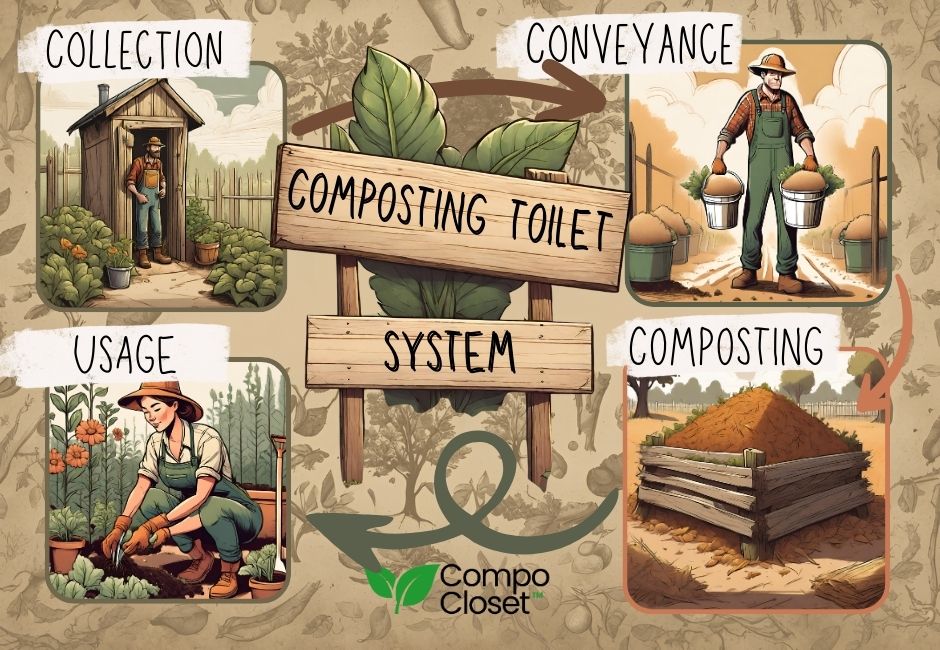Choosing the Best Portable Composting Toilet for Off-Grid Adventures
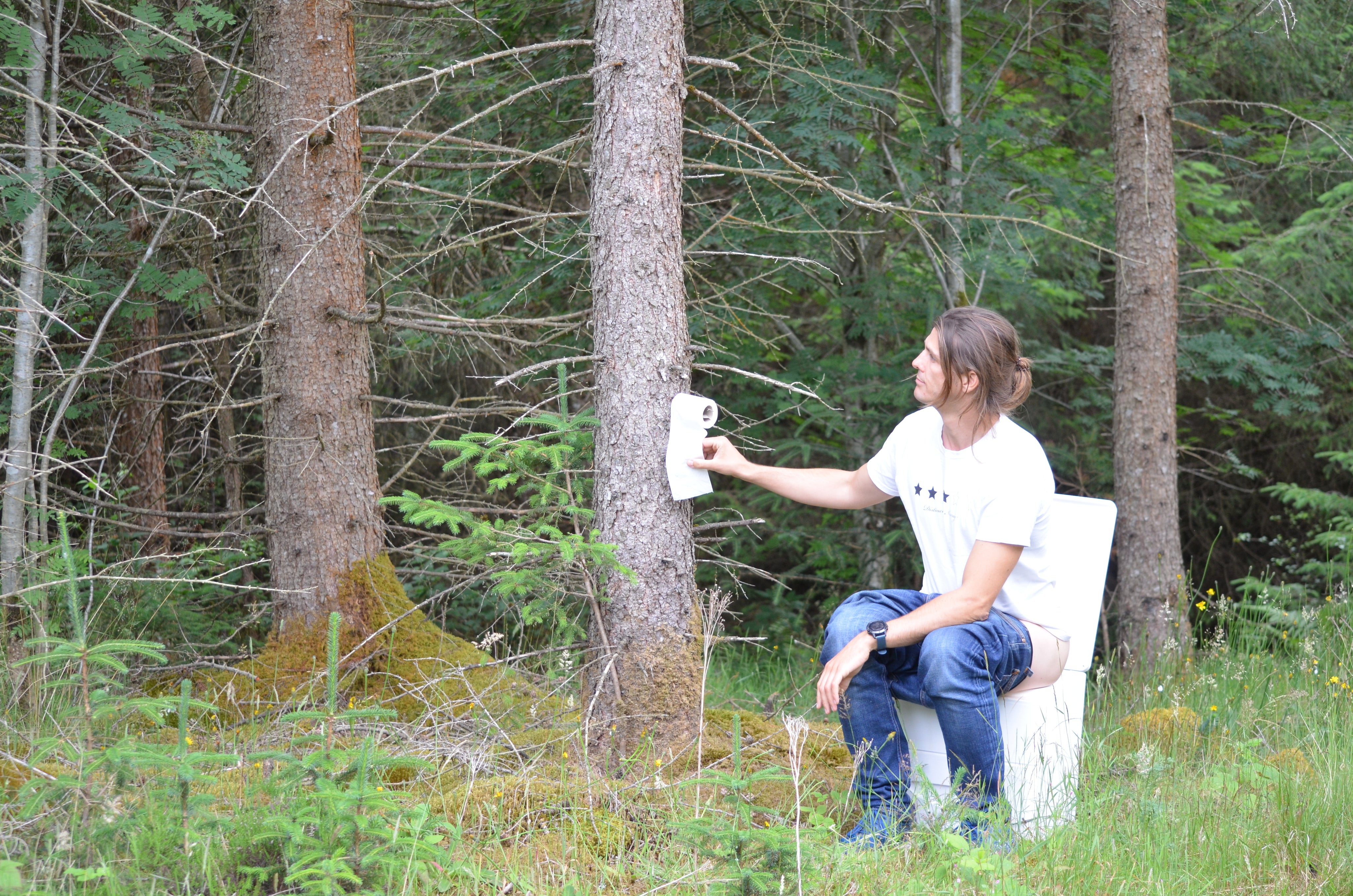
When it comes to portable composting toilets, there is a wide array of options available in the market. From compact design to advanced features like agitators, covers and carbon filters, understanding the key factors to consider will help you choose the perfect one for your needs.
Whether you're planning a camping trip or venturing into remote areas, having a portable composting toilet can make a world of difference. Not only does it offer convenience and comfort, but it also ensures that you leave no trace behind, promoting sustainable and eco-friendly practices.
Benefits of using a portable composting toilet
Portable composting toilets offer a range of benefits that make them a must-have for outdoor enthusiasts. Here are some key advantages:
1. Stay off-grid longer
One of the primary reasons to invest in a portable composting toilet is the ability to stay in remote natural places longer than a chemical toilet. Unlike a chemical toilet because urine is separated at source it can be disposed of in nature - away from water sources and other people (hikers and campers). Always be considerate of others and choose a mature tree as it can be a potent fertiliser
2. Environmentally Friendly
Using a portable composting toilet promotes sustainable and eco-friendly practices. These toilets are designed to facilitate the decomposition of human waste using natural processes, such as composting and evaporation instead of masking smells with chemicals. By using a composting toilet, you contribute to minimizing pollution, protecting water sources, and preserving the environment.
3.Convenience and Time

Having a portable composting toilet with you quickly becomes a can't-live-without convenience, especially if travelling with children. An easily accessible toilet in your car or camper can turn any parking spot into a private, safe and clean restroom, saving time driving out of the way.
Additionally, most of the volume is urine which is more readily disposed of when separated from solids. This means less frequent emptying and so less time looking for the dreaded dump point.
4. No Trace Left Behind

One of the essential principles of responsible outdoor recreation is leaving no trace behind. With a portable composting toilet, you can ensure that you're not leaving any waste or harmful substances in behind so everyone can enjoy unspoilt nature.
Factors to consider when choosing a portable composting toilet
When selecting a portable composting toilet, it's crucial to consider various factors to ensure the best fit for your needs. Here are the key factors to keep in mind:
1. Size and Portability
It goes without saying but be sure to look for a portable toilet that makes carrying easier. Handles on the sides as well as access points in the front and rear are useful for moving a portable toilet in and out of tight spaces. Look for compact designs that are lightweight and easy to transport without compromising on comfort and functionality. For increased convenience a carry-bag is a good upgrade and can make setting up camp easier. If your portable composting toilet features a handle or ventilation holes, be sure the bag has access slots and vent holes for these as well.
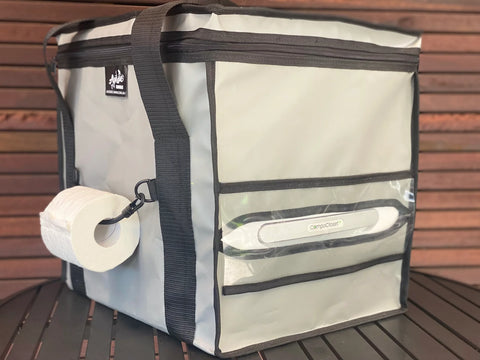
2. Capacity
Consider the capacity of the toilet's solids bin and urine canister as well as the durability of the overall construction. We recommend a urine tank capacity of at least 0.5Galon (2L) per day for adults (half for children) so you're not emptying constantly. For solids, we prefer a capacity that will surpass the requirements for your trip so that materials can be packed-out at the end of your trip, leaving no residual waste. for portable bag systems, be sure to allow space for carbon rich cover material in the solids bin to control odors.
3. Durability
Life in the wild can be tough. Look for a unit with strong quality materials and hardware, built to withstand rugged outdoor conditions and wear and tear.
4. Odor Control Mechanisms
Effective odor control is an important feature to consider in a portable composting toilet. Look for toilets that incorporate ventilation systems, carbon filters, or urine valves/membrane to minimize unpleasant odors. For units with external ventilation, ensure a fly screen is included as standard (as with all Cuddy composting toilets). This ensures a more pleasant experience and makes the toilet more suitable for use in convenient proximity to camping areas or other outdoor settings.
Types of portable compost toilets
There are two main types of portable composting toilets, each with its own unique features and functionalities.
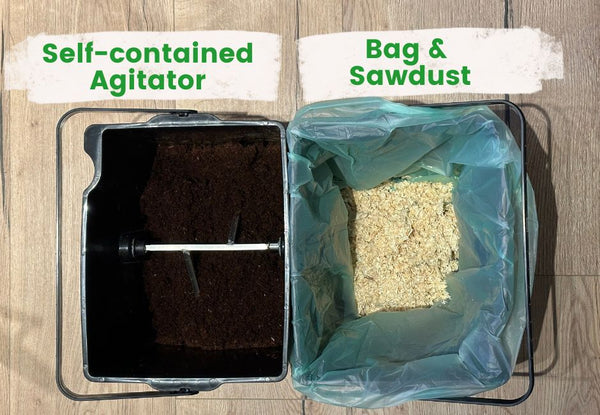
1. Self-Contained Units
Self-contained units are a popular choice for outdoor enthusiasts due to their compact size and ease of use. These toilets feature a solids bin with an agitator and a separate compartment for urine. They are designed to be completely self-contained, requiring no external plumbing or water source. Self-contained units are often lightweight and portable, making them ideal for camping, boating, or RV trips. The biggest benefit of a self contained system is not needing to keep cover material nearby to add to the solids bin after each use.
2. Portable Bag Systems
Portable bag systems are a simpler alternative for outdoor adventures. These systems typically line the solids bin with a biodegradable bag. They are designed to have carbon-rich cover material added after each use to begin the composting process and reduce odor.
Pros and Cons of self-contained vs portable bag system
The biggest advantage of self-contained composting toilets is that no additional space or materials are required. Instead, the cover material is all added at the start and mixed after each use, avoiding hassle and spills when camping. An additional benefit of agitating is that the composting process happens faster.
The benefit of the portable bag system is the convenience of emptying as the solids bin remains clean once the bag is removed. This may be preferable for intermittent use.
Features to look for in a portable composting toilet
To ensure the best performance and user experience, consider the following features when choosing a portable composting toilet:
1. Separation of Liquid and Solid Waste
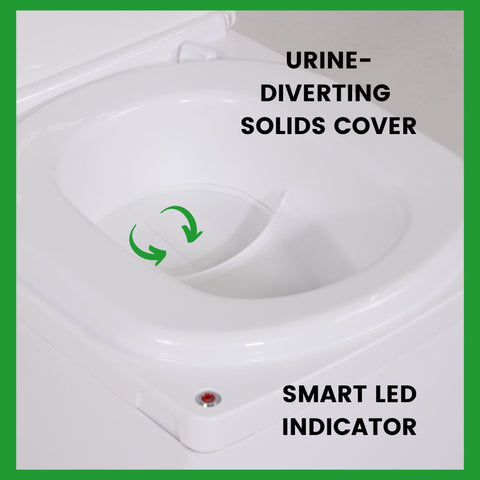
To enhance the composting process and minimize odors, opt for toilets that separate liquid and solid waste. The separation of solids and liquids is achieved through a urine diverter in the toilet seat which allows urine to flow into a separate urine canister. This prevents the formation of anaerobic conditions and accelerates the composting process.
By separating the urine from solids, the urine can be disposed of separately. Always check local regulations in your country, however, if you are in the wilderness it is normally legal to dispose of urine away from any campsites over a mature tree. If you are on a campsite, you can dispose of it in a regular toilet or dump point.
2. Ventilation System

A well-designed ventilation system is crucial for controlling odors and promoting the composting process. Look for toilets with built-in fans or vents that facilitate airflow and prevent the accumulation of unpleasant smells.
An activated carbon filter is an advanced feature of a ventilation system and will help reduce odors even further.
3. Ease of Emptying and Maintenance
Consider the ease of emptying the waste tank and the overall maintenance requirements of the toilet. Look for features such as removable solids and liquids tanks, hinges to prevent disassembly, and an easy to wipe-clean design. Easy maintenance ensures a hygienic and hassle-free experience.
4. Advanced Features for a more pleasant experience
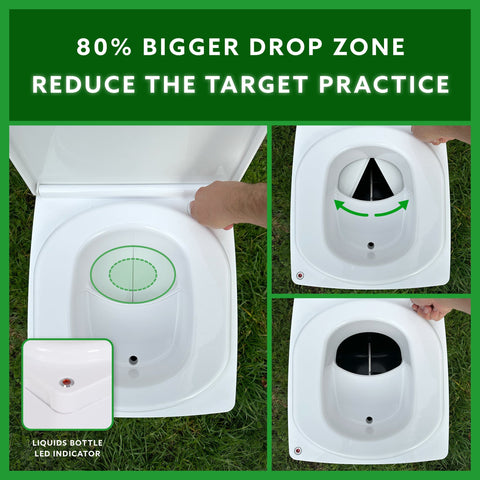
At Compo Closet we don't believe in guessing when the liquids are full (or failing to guess!) so we installed a liquids level indicator. We also don't like looking at our poop (or anyone else's for that matter) so our drop zone features a retractable cover to hide the poo from view. The cover also diverts stray urine to keep the solids dry and reduce odor!
Tips for using a portable composting toilet in different outdoor settings
Using a portable composting toilet in various outdoor settings requires some considerations. Here are some tips to help you make the most of your toilet in different scenarios:
1. Camping
When camping, ensure that you set up your toilet in a discreet location, away from tents and cooking areas. Follow campground regulations and guidelines for waste disposal. Dispose of waste properly, either by transferring it to designated facilities or by burying it according to local regulations.
2. RV & Camper Trips
When traveling in an RV or camper, portable composting toilets offer a convenient alternative to traditional RV toilets. The setup options for for RVs and campers are endless. Portability means lots more installation options such. These typically include in a bench or slide-out for RVs, or putting in an en-suite (off-suite?), tent or loo-with-a-view for teardrop trailers and truck campers.
3. Boating
Portable composting toilets are much simpler than marine toilets and can typically be installed yourself. Due to not requiring a large storage tank, they allow for more storage space for other necessities. Look for designs such as Cuddy that can be trimmed back at the base and re-sealed to account for the shape of the hull. Also be sure to allow for clearance at the back for hinges - Cuddy Composting toilets feature stainless hinges that articulate so no space is required behind the toilet.
If you will be boating boating at sea, be sure to select quality materials that are corrosion resistant. Compo Closet's toilets now feature stainless steel hardware for increased durability.
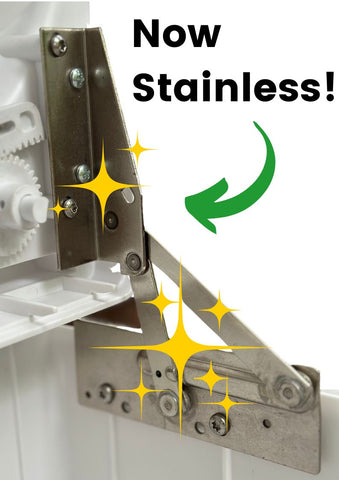
Toilet paper in portable toilets
Toilet paper is very bulky once it's off the roll and can quickly fill a portable toilet. When camping with a dry toilet, we suggest keeping toilet paper in a separate bag or container beside the toilet and disposing of it separately. This can most easily be burned on the campfire or disposed of in the trash, but always be considerate of others when disposing of your waste.
Where to empty your portable toilet on the road
One of the largest advantages of separating toilets is that urine is more readily disposed of than black water and solid waste. In the wilderness, urine can normally be disposed of over a mature tree, away from water sources and other people, but always check the local regulations and be considerate of others when doing this. On campsites, urine can be disposed of in a regular toilet, or the dump point.
For solids, the most environmental solution is to size your toilet so you can pack your waste out with you and compost it at home. It's surprising how long a solids bin can take to fill when urine is separated. When testing Cuddy, I travelled independently for 28 days, using only Cuddy and still had capacity.
If you're on the road and its time to empty the solids bin, we don't advise digging a large cat hole - the size and depth required could be damaging to the environment. Instead, it is typically legal to dispose of the material in the trash like diapers, however, always check local regulations and be considerate of others when choosing your bin.
Common misconceptions about portable composting toilets
Despite their advantages, portable composting toilets are often surrounded by misconceptions. Here are some common myths debunked:
1. They are Smelly and Unsanitary
Properly designed and maintained portable composting toilets are not smelly or unsanitary. Odor control mechanisms and the composting process effectively neutralize smells. Regular cleaning and maintenance ensure a hygienic experience.
2. They are Complicated to Use
Portable composting toilets are designed to be user-friendly and easy to use. The largest difference is that everyone sits to pee and people with a cervix may need to aim slightly by adjusting their pelvis.
3. They are Expensive
Composting toilets offer off-grid independence so boondocking and dry-camping can become the norm. While composting toilets typically cost more than chemical toilets, the money saved on campsite fees make a portable composting toilet a cost-effective and sustainable choice for the long run.
Making an informed decision for your outdoor adventures
A portable composting toilet can give you the freedom an independence to explore more remote areas. Remember to prioritize portability, durability, and odor control when selecting a toilet. Carbon-rich cover materials are the essential ingredient for managing odors. Following guidelines for waste disposal in different outdoor settings ensures responsible and sustainable practices and protects the environment for future generations.
With the right portable composting toilet by your side, you can enjoy the convenience, comfort, and sustainability benefits on your outdoor adventures. So, go ahead and make the best choice for yourself and the planet. Happy exploring!
0 comments

